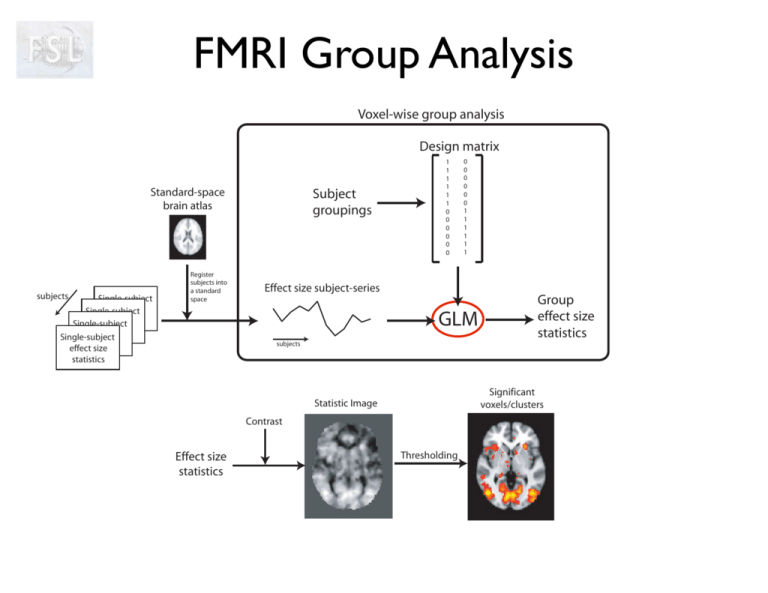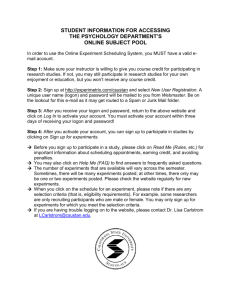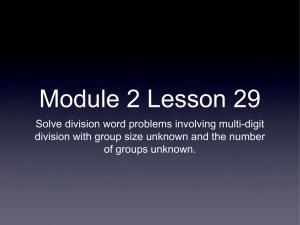FMRI Group Analysis
advertisement

FMRI Group Analysis Voxel-wise group analysis Design matrix Standard-space brain atlas subjects Single-subject effect size Single-subject statistics effect size Single-subject statistics effect size Single-subject statistics effect size statistics Register subjects into a standard space Subject groupings 1 1 1 1 1 1 0 0 0 0 0 0 0 0 0 0 0 0 1 1 1 1 1 1 Effect size subject-series GLM Group effect size statistics subjects Significant voxels/clusters Statistic Image Contrast Effect size statistics Thresholding Multi-Level FMRI analysis • • Mark Steve uses GLM at both lower and higher levels typically need to infer across multiple subjects, sometimes multiple groups and/or multiple sessions Difference? Group 1 Group 2 Karl Will Tom Andrew Josephine Anna Hanna Sebastian Lydia Elisabeth session 1 session 1 session 1 session 1 session 1 session 1 session 1 session 1 session 1 session 1 session 1 session 1 session 2 session 2 session 2 session 2 session 2 session 2 session 2 session 2 session 2 session 2 session 2 session 2 session 3 session 3 session 3 session 3 session 3 session 3 session 3 session 3 session 3 session 3 session 3 session 3 session 4 session 4 session 4 session 4 session 4 session 4 • session 4 questions of interest involve comparisons at the highest level session 4 A simple example Does the group activate on average? Group Mark Steve Karl Will Tom Andrew A simple example Does the group activate on average? Group Mark Steve Karl Will 0 Tom Andrew effect size A simple example Does the group activate on average? Group Mark Yk = Xk Steve k Karl Will Tom Andrew + ⇥k First-level GLM on Mark’s 4D FMRI data set 0 effect size A simple example Does the group activate on average? Group Mark Yk = Xk Mark’s effect size Steve k Karl Will Tom Andrew + ⇥k 0 effect size A simple example Does the group activate on average? Group Mark Yk = Xk Steve k Karl Will Tom Andrew + ⇥k Mark’s within-subject variance 0 effect size A simple example Does the group activate on average? Group Mark YK = XK Steve K Karl Will Tom Andrew + ⇥K All first-level GLMs on 6 FMRI data set 0 effect size A simple example Does the group activate on average? Group Mark Steve Karl Will Tom Andrew What group mean are we after? Is it: 1. The group mean for those exact 6 subjects? Fixed-Effects (FE) Analysis 2. The group mean for the population from which these 6 subjects were drawn? Mixed-Effects (ME) analysis Fixed-Effects Analysis Do these exact 6 subjects activate on average? Group Mark Steve Karl estimate group effect size as straight-forward mean across lower-level estimates Will Tom Andrew 0 effect size g 1 = 6 6 k k=1 Fixed-Effects Analysis Do these exact 6 subjects activate on average? Group Mark Steve YK = XK K ⇧ ⇧ ⇧ Xg = ⇧ ⇧ ⇧ ⇤ = Xg 1 1 1 1 1 1 ⇥ ⌃ ⌃ ⌃ ⌃ ⌃ ⌃ ⌅ K Karl Will Tom Andrew + ⇥K g 0 Group mean effect size g 1 = 6 6 k k=1 Fixed-Effects Analysis Do these exact 6 subjects activate on average? Group Mark Steve Karl YK = XK K = Xg Will K Tom + ⇥K g Fixed Effects Analysis: • Consider only these 6 subjects estimate the mean across these subject only variance is within-subject variance • • Andrew A simple example Does the group activate on average? Group Mark Steve Karl Keith Tom Andrew What group mean are we after? Is it: 1. The group mean for those exact 6 subjects? Fixed-Effects (FE) Analysis 2. The group mean for the population from which these 6 subjects were drawn? Mixed-Effects (ME) analysis Mixed-Effects Analysis Does the population activate on average? Group Mark YK = XK Steve K Karl Keith • Andrew + ⇥K Consider the distribution over the population from which our 6 subjects were sampled: 2 g Tom g 0 is the between-subject variance g effect size k Mixed-Effects Analysis Does the population activate on average? Group Mark Steve YK = XK = Xg K ⇧ ⇧ ⇧ Xg = ⇧ ⇧ ⇧ ⇤ 1 1 1 1 1 1 ⇥ ⌃ ⌃ ⌃ ⌃ ⌃ ⌃ ⌅ K g Karl Keith Tom Andrew + ⇥K + ⇥g g 0 Population mean betweensubject variation g effect size k Mixed-Effects Analysis Does the population activate on average? Group Mark Steve Karl YK = XK K = Xg • Keith Tom Andrew + ⇥K + ⇥g K g Mixed-Effects Analysis: Consider the 6 subjects as samples from a wider population estimate the mean across the population between-subject variance accounts for random sampling • • All-in-One Approach Difference? Group 1 Mark Steve Karl Will Tom Andrew Group 2 Josephine Anna Hanna Sebastian Lydia Elisabeth session 1 session 1 session 1 session 1 session 1 session 1 session 1 session 1 session 1 session 1 session 1 session 1 session 2 session 2 session 2 session 2 session 2 session 2 session 2 session 2 session 2 session 2 session 2 session 2 session 3 session 3 session 3 session 3 session 3 session 3 session 3 session 3 session 3 session 3 session 3 session 3 session 4 session 4 session 4 session 4 session 4 session 4 • session 4 Could use one (huge) GLM to infer group difference • • • difficult to ask sub-questions in isolation computationally demanding need to process again when new data is acquired session 4 Summary Statistics Approach In FEAT estimate levels one stage at a time • At each level: • • • Inputs are summary stats from levels below (or FMRI data at the lowest level) Group difference Group Outputs are summary stats or statistic maps for inference Need to ensure formal equivalence between different approaches! Subject Session FLAME FMRIB’s Local Analysis of Mixed Effects • • • Fully Bayesian framework • • • use non-central t-distributions: Input COPES,VARCOPES & DOFs from lower-level estimate COPES,VARCOPES & DOFs at current level pass these up Infer at top level Equivalent to All-in-One approach Z-Stats Group difference COPES VARCOPES DOFs Group COPES VARCOPES DOFs Subject COPES VARCOPES DOFs Session FLAME Inference • • Default is: • FLAME1: fast approximation for all voxels (using marginal variance MAP estimates) Optional slower, slightly more accurate approach: • FLAME1+2: • FLAME1 for all voxels, FLAME2 for voxels close to threshold • FLAME2: MCMC sampling technique Choosing Inference Approach 1. Fixed Effects Use for intermediate/top levels 2. Mixed Effects - OLS Use at top level: quick and less accurate 3. Mixed Effects - FLAME 1 Use at top level: less quick but more accurate 4. Mixed Effects - FLAME 1+2 Use at top level: slow but even more accurate FLAME vs. OLS • • • • allow different within-level variances (e.g. patients vs. controls) allow non-balanced designs (e.g. containing behavioural scores) pat ctl 0 effect size ... allow un-equal group sizes solve the ‘negative variance’ problem < Session < Subject Group FLAME vs. OLS • Two ways in which FLAME can give different Z-stats compared to OLS: FLAME OLS • higher Z due to increased efficiency from using lower-level variance heterogeneity FLAME vs. OLS • Two ways in which FLAME can give different Z-stats compared to OLS: FLAME OLS • Lower Z due to higher-level variance being constrained to be positive (i.e. solve the implied negative variance problem) Multiple Group Variances pat ctl • can deal with multiple variances • separate variance will be 0 estimated for each variance group (be aware of #observations for each estimate, though!) • design matrices need to be ‘separable’, i.e. EVs only have non-zero values for a single group valid invalid group effect size Examples Single Group Average • We have 8 subjects - all in one group - and want the mean group average: • • estimate mean • test significance of mean > 0 estimate std-error (FE or ME) subject Does the group activate on average? 0 effect size >0? Single Group Average subject Does the group activate on average? 0 effect size Single Group Average Does the group activate on average? Unpaired Two-Group Difference • We have two groups (e.g. 9 patients, 7 controls) with different between-subject variance • • estimate means • test significance of difference in means estimate std-errors (FE or ME) subject Is there a significant group difference? 0 >0? effect size Unpaired Two-Group Difference subject Is there a significant group difference? 0 effect size Unpaired Two-Group Difference subject Is there a significant group difference? 0 effect size Unpaired Two-Group Difference Is there a significant group difference? Paired T-Test 8 subjects scanned under 2 conditions (A,B) Is there a significant difference between conditions? subject • 0 effect size Paired T-Test 8 subjects scanned under 2 conditions (A,B) Is there a significant difference between conditions? try non-paired t-test subject • 0 effect size >0? Paired T-Test 8 subjects scanned under 2 conditions (A,B) Is there a significant difference between conditions? data 0 subject de-meaned data subject • effect size subject mean accounts for large prop. of the overall variance 0 effect size Paired T-Test 8 subjects scanned under 2 conditions (A,B) Is there a significant difference between conditions? data 0 subject de-meaned data subject • effect size subject mean accounts for large prop. of the overall variance 0 >0? effect size Paired T-Test subject Is there a significant difference between conditions? 0 effect size Paired T-Test subject Is there a significant difference between conditions? 0 effect size Paired T-Test Is there a significant difference between conditions? EV1models the A-B paired difference; EVs 2-9 are confounds which model out each subject’s mean Paired T-Test Is there a significant difference between conditions? Multi-Session & Multi-Subject • 5 subjects each have three sessions. Does the group activate on average? • Use three levels: in the second level we model the within-subject repeated measure Multi-Session & Multi-Subject • 5 subjects each have three sessions. Does the group activate on average? • Use three levels: in the third level we model the between-subjects variance Multi-Session & Multi-Subject • • • 5 subjects each have three sessions. Does the group activate on average? Use three levels: • in the second level we model the within subject repeated measure typically using fixed effects(!) as #sessions are small • in the third level we model the between subjects variance using fixed or mixed effects Reducing variance subject subject Does the group activate on average? 0 effect size >0? mean effect size large relative to std error 0 effect size >0? mean effect size small relative to std error Reducing variance subject subject Does the group activate on average? 0 effect size >0? mean effect size large relative to std error 0 effect size >0? mean effect size large relative to std error Single Group Average & Covariates • We have 7 subjects - all in one group. We also have additional measurements (e.g. age; disability score; behavioural measures like reaction times): • use covariates to ‘explain’ variation • • estimate mean subject Does the group activate on average? estimate std-error (FE or ME) 0 effect size Single Group Average & Covariates • We have 7 subjects - all in one group. We also have additional measurements (e.g. age; disability score; behavioural measures like reaction times): • use covariates to ‘explain’ variation • • estimate mean subject Does the group activate on average? estimate std-error (FE or ME) 0 effect size slow RT fast Single Group Average & Covariates • We have 7 subjects - all in one group. We also have additional measurements (e.g. age; disability score; behavioural measures like reaction times): • use covariates to ‘explain’ variation • • estimate mean subject Does the group activate on average? estimate std-error (FE or ME) 0 effect size slow RT fast Single Group Average & Covariates • We have 7 subjects - all in one group. We also have additional measurements (e.g. age; disability score; behavioural measures like reaction times): • use covariates to ‘explain’ variation • • estimate mean subject Does the group activate on average? estimate std-error (FE or ME) 0 effect size slow RT fast Single Group Average & Covariates • We have 7 subjects - all in one group. We also have additional measurements (e.g. age; disability score; behavioural measures like reaction times): • use covariates to ‘explain’ variation • • estimate mean subject Does the group activate on average? estimate std-error (FE or ME) 0 effect size slow RT fast Single Group Average & Covariates Does the group activate on average? • • use covariates to ‘explain’ variation need to de-mean additional covariates! FEAT Group Analysis • Run FEAT on raw FMRI data to get first-level .feat directories, each one with several (consistent) COPEs • • low-res copeN/varcopeN .feat/stats when higher-level FEAT is run, highres copeN/ varcopeN .feat/reg_standard FEAT Group Analysis • Run second-level FEAT to get one .gfeat directory • Inputs can be lowerlevel .feat dirs or lower-level COPEs • the second-level GLM analysis is run separately for each first-level COPE • each lower-level COPE generates its own .feat directory inside the .gfeat dir That’s all folks Appendix: Group F-tests • 3 groups of subjects Is any of the groups activating on average? ANOVA: 1-factor 4-levels • 8 subjects, 1 factor at 4 levels Is there any effect? • • EV1 fits cond. D, EV2 fits cond A relative to D etc. F-test shows any difference between levels ANOVA: 2-factor 2-levels • 8 subjects, 2 factor at 2 levels. FE Anova: 3 F-tests give standard results for factor A, B and interaction • If both factors are random effects then Fa=fstat1/fstat3, Fb=fstat2/fstat3ME • ME: if fixed fact. is A, Fa=fstat1/fstat3 ANOVA: 3-factor 2-levels • • 16 subjects, 3 factor at 2 levels. • For random/mixed effects need different Fs. Fixed-Effects ANOVA: Understanding FEAT dirs • First-level analysis: Understanding FEAT dirs • Second-level analysis: That’s all folks







